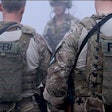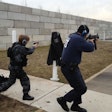There is a quiet debate in SWAT that starts with the question: Which team is the “best?” Followed by: Which teams are “better.”
The only time SWAT teams compete against each other is during SWAT competitions for “bragging rights.” And while such competitions are important, SWAT’s real opponents are the bad guys. That’s the competition you can’t afford to lose.
SWAT can never afford to lose in real-life confrontations because losing means someone dies. The result is SWAT must win every time, period. So your SWAT team must always be the best.
This brings me to the full-time vs. part-time SWAT debate. Which is best? The better question is whether your team is good enough to win every confrontation it faces. If not, you better know why not. And then take the steps to correct it.
Available figures show the majority of SWAT teams in the United States and Canada are part-time, meaning SWAT is secondary to regular assignments (patrol, detective, etc.) The reason for this is that only the largest law enforcement agencies (mainly those in major cities) can afford the personnel resources needed for full-time SWAT teams.
Let’s discuss some of the advantages and disadvantages of both:
Full-time SWAT
The obvious advantage to full-time SWAT teams is they get to “SWAT” every day, instead of only during callouts and training. They’re able to hone their skills, perfect their timing, and their teamwork. Full-time teams are called out more often than part-time teams. Generally, full-time SWAT teams are experienced, well-oiled machines, or at least they should be.
Yet, despite these advantages, and contrary to the perception that full-time teams “have it made,” they also have disadvantages. A primary disadvantage is understaffing, reflecting most agencies’ shortages of personnel, along with SWAT often being considered a “nice to have” luxury.
Another disadvantage is difficulty providing 24/7 SWAT coverage. With the exception of NYPD ESU, there are only a handful of full-time teams providing 24/7 coverage. The result is most full-time teams are on duty during peak hours, but all are on call 24/7.
Full-time SWAT also faces the very real perception of elitism, a common complaint between patrol and specialized units. The result is that full-time teams need to work to dispel this perception and to bridge the gap between “them” and “us” by spearheading their department’s tactical response and training. A good example is rapid deployment training for active shooters.
Next, full-time SWAT teams are sometimes misused, abused, or overused, if/when their agencies don’t understand or believe in the SWAT mission. Some police administrators consider SWAT as “bodies” to be used for filling in wherever there is a need for bodies, regardless of whether the job has anything to do with SWAT.
Examples of how extreme this can get include detailing SWAT personnel completely away from SWAT or the time one agency came very close to reassigning SWAT to 24/7 station security. Fortunately, wiser minds prevailed, and the plan was abandoned.
Full-time teams can also be “overused,” handling far too many assignments. The predictable result is often burnout and inefficiency with the strong potential for disaster.
Part-Time SWAT
Since part-time teams only “SWAT” during training and callouts, they often struggle to attain the NTOA recommended two-training days per month minimum. Also, real experience can be hard to come by because callouts may be very infrequent. The result is a team that may not be ready when the time comes.
Another challenge for part-time SWAT team members is wearing two hats. Hat one is their regular assignment, and hat two is SWAT. Depending on the agency and supervision, this can be a disadvantage or an advantage. Disadvantages include not being allowed to carry SWAT equipment on the street, and/or working for supervisors who have no use for SWAT, to the extreme of refusing to callout SWAT when they should.
Yet, part-time SWAT also has advantages. The perception of elitism is greatly diminished because SWAT officers are assigned to the same duties as “regular” officers.
Also, part-time SWAT officers are often on the street 24/7 and, in progressive departments, carrying their equipment, which is a distinct advantage for rapid deployment to active shooters.
As you can see, both team concepts have their advantages and disadvantages, and they both face unique challenges.
But whether you are full- or part-time SWAT doesn’t matter to the bad guys you face on callouts. As all of us in SWAT know, we must win—prevail if you prefer—on each and every callout. And to win, we must make the best of the hand we’re dealt while constantly striving to improve.












